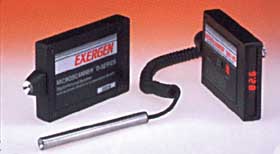 Infrared
Temperature Sensors Exergen D-Series is an entirely
different type of instrument than conventional
temperature measuring devices.
Infrared
Temperature Sensors Exergen D-Series is an entirely
different type of instrument than conventional
temperature measuring devices.
Exergen D-Series Infrared
Temperature Sensors
are designed
specifically for the highest possible accuracy.
Exergen
D-Series Infrared
Temperature Sensors
are the only infrared instruments which can be
certified as to NIST-tracable accuracy on real
surfaces of unknown emissivity, while completely
free of contact errors and heat sinking errors
of contact devices.
Emissivity Errors
The true emissivity of a surface is known only
approximately. Conventional Infrared
Temperature Sensors
without Exergen's Automatic Emissivity Compensation
System can only display an approximate temperature
over their entire temperature range. The "accuracy"
specifications given by most manufacturers are
only for a "black body" calibration
and do not hold outside laboratory conditions.
Black body calibrations do not include emissivity
shifts, ambient change effects on the target,
and other phenomena that introduce significant
errors.
Emissivity
Shift Errors
Even if an IR "gun" is set to the correct
emissivity to read a surface accurately at a particular
temperature, it does not mean that the IR "gun"
will read the same target correctly at other temperatures.
Emissivity of virtually all surfaces changes with
temperature. A common assumption for conventional
IR thermometry is that emissivity is constant
with changes in target surface temperature. Real
materials do not have this characteristic.
User Adjustment
Errors
A setting of emissivity = 0.9 on an IR "gun"
from one manufacturer will not necessarily match
that of another IR "gun" manufacturer.
There are no standards set in the industry on
the precise measurement and meaning of "emissivity".
Also, Quality
Assurance programs should not rely upon any instrument
that allows users to alter the instrument settings
and to let it display whatever the user wishes.
Background Reflection Errors
Even if emissivity is constant there are still
errors induced by changing ambient
temperatures. For example, with emissivity = 0.9,
ambient reflections account for 10% of the signal
that the IR "gun" will see. If ambient
changes, the IR "gun" will display a
different target temperature, even if the target
remains at the same temperature.
Contact Errors
Thermocouples, RTDs. thermistors, and other contact
devices only measure their own temperature. They
do not measure surface temperature. Published
"Accuracy" specifications are for the
probes only, not the surfaces they must measure.
Users must guarantee that the probes are brought
the same temperature as the surface. Can you guarantee
that your probes are brought to the same temperature
as the targets to be measured?
Friction Heating
Errors
For moving surfaces, a contact probe is prone
to frictional heating. The size of the error is
dependent on the roughness of the surface, the
speed, the coating on the probe, and so on. It
is impossible to control all the variables.
Heat Sinking
Errors
For most non-metals, heat sinking errors can be
quite large. The heat transfer rate of the metal
leads required on "contact probes" conducts
heat faster than the target material can replace,
resulting in unknown and fairly large errors.
In general, the less dense the target material,
the larger the heat sinking error with a contact
probe.
Time Based
Errors
Contact temperature probes are slow. The temperature
of a target can change more quickly than most
probes, resulting in errors in real time measurement.
Infrared
Temperature Sensors Exergen D-Series
Microscanner the only Certified Accurate Surface
Temperature Instrument in the World!